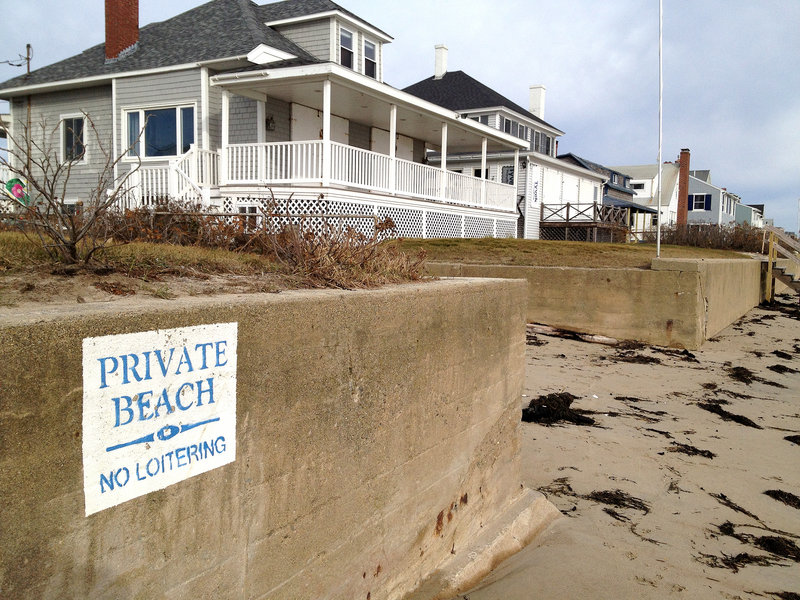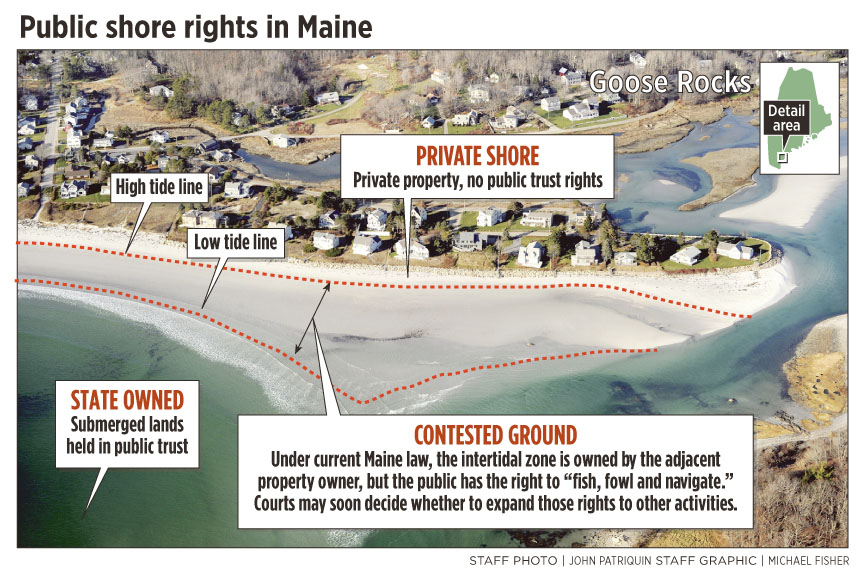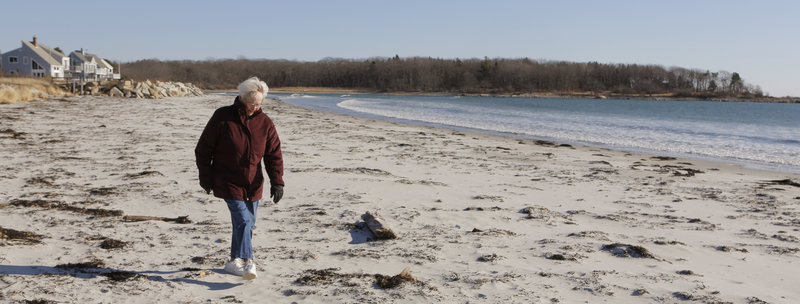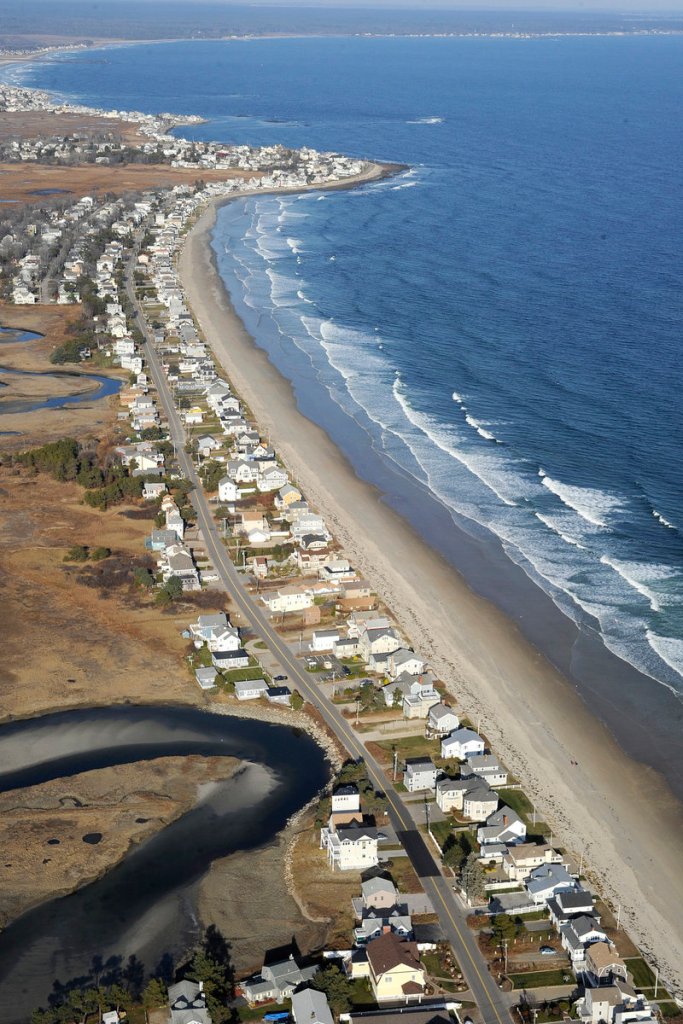KENNEBUNKPORT – Joan Junker has spent every summer since 1930 — and the past 36 winters as well — here at Goose Rocks Beach, a 2½-mile sweep of fine white sand facing the ocean.
Her parents started coming in 1908, bought the family cottage one house back from the dunes in 1925 and moved here year-round a quarter century later. She met her future husband walking the beach where their friends had long played, walked and swam.
But if some of her neighbors have their way, she’d have no right to walk on the beach at all. The lawsuit they launched to stop her could finally decide whether she and other Mainers can legally stroll, sunbathe or build sand castles anywhere along the state’s 3,500 miles of shoreline.
In mid-October, a judge affirmed the public’s right to swim, stroll and recreate on Goose Rocks Beach, rejecting a claim by 29 oceanfront lot owners to have exclusive rights to do these things on the wet sand exposed at low tide. It was a victory for Junker, hundreds of other back-lot cottagers, and the town of Kennebunkport, who argued they and the public had always used the beach and always should.
It was only a partial victory for Mainers everywhere. The ruling expanded their rights to cross intertidal shores to engage in a broad range of activities, including boogie boarding, jet skiing and windsurfing. But if appealed, which is expected, Maine’s highest court will have an opportunity to decide if the public has the right to sit, build sand castles, or simply walk below the high-water mark as generations of Mainers always had.
The struggle over public rights to Maine’s wide intertidal shore is heating up, increasing the chance that Maine’s Supreme Judicial Court might review a watershed ruling made 23 years ago that many legal scholars, citizens and the state of Maine itself believe was wrongly decided.
The decades-long conflict pits a restrictive 365-year-old Massachusetts colonial ordinance against a notion that is backed by law in most of the country: that the sea floor exposed at low tide is in essence a public good and should be open to strollers, bathers and children building sand castles.
After recreating on Goose Rocks Beach for eight decades, Junker thought such rights existed in Maine, too. Nobody had ever sought permission to use the beach — dry sand or wet — and the two beachfront owners who objected in the past were seen as eccentrics. So when she heard three years ago that her oceanfront neighbors were suing to assert ownership of the beach, she was dumbfounded. “I couldn’t believe it,” she recalls, sitting at her son’s home on the other end of the beach. “The idea that the beachfront owners owned the beach, it had never occurred to us.”
A CONTROVERSIAL DECISION
Not long ago, Mainers assumed they already had “public trust” rights to the shore, and had behaved accordingly for generations. People walked the flats, used beaches as highways and airports and places to drive cattle, and sat on rocks from Kittery to Lubec while their children played in tidal pools. Below high tide, nobody thought to ask a landowner’s permission to access the seabed, and few landowners would have expected to be asked.
But in 1989, Maine’s high court ruled in favor of a group of beachfront homeowners on Moody Beach in Wells who had asserted their right to kick beachgoers off the sand, effectively privatizing the beach. That case, Bell v. Town of Wells, is sort of the Citizens United of Maine shoreland jurisprudence: a 4-3 ruling with wide-ranging ramifications that has been widely condemned by legal scholars and dissenting justices and is seen by many as a departure from previous case law.
“There is no doubt that the public has been walking in the intertidal zone in Maine as long as anybody can remember, and that they did so up until recently without objection,” says Deputy Attorney General Paul Stern, who has spent nearly a quarter century fighting to overturn the decision. “We view the Bell decision as an aberration, and that it was wrong from many different perspectives.”
The Moody Beach decision held that the only shore activities members of the public had rights to were those enumerated in a Colonial ordinance adopted by the Massachusetts Bay Colony in 1647, several years before it began annexing settlements in Maine: fishing, fowling and navigation. Everything else — walking, surfing, bird-watching and sunbathing — required the permission of waterfront property owners, who could prosecute violators for trespass. The court also declared Maine’s 1986 Intertidal Land Act — which guaranteed public recreational use of such shoreland — unconstitutional.
“Massachusetts and Maine law are totally in sync with the fact that the Colonial ordinance granted a limited (public) easement over the intertidal zone for specific purposes and no others,” says attorney Pete Thaxter of Curtis Thaxter in Portland, who represented oceanfront owners in both the Moody and Goose Rocks Beach cases. “Private property is private property, and if you want to take it away you have to compensate owners.”
Critics have savaged the ruling on many fronts. The 1647 ordinance, they argue, flies in the face of 2,000 years of legal practice dating back to ancient Rome and enshrined in English common law and North American custom. (“Things common to mankind by the law of nature are the air, running water, the sea, and consequently the shores of the sea,” the 5th- century Justinian Code reads. “No man therefore is prohibited from approaching any part of the seashore.”) The English crown held title to the shore, delegating its sovereign control to its early American Colonies, most of which retain ownership today as states.
AN ANCIENT ORDINANCE
Early Maine was no different, but the Puritans of Massachusetts had their own ideas — including the notion that they were God’s chosen people — and presumed to govern their Calvinist utopia-in-the-making themselves. Tensions between that colony’s citizens and magistrates became strained as the latter ignored constraints on their power in English common law. This resulted in the official compilation — in the midst of the cataclysmic English Civil War, in which the king was beheaded — of a written codex of rights and liberties of the Bay Colony’s citizenry.
This document was commissioned in 1641, completed in 1647, and would be of little interest to Mainers today if it did not contain the following passages: “Everie Inhabitant who is a hous-holder shall have free fishing and fowling in any great ponds, bayes, Coves and Rivers, so far as the Sea ebbs and flows. … Where the sea ebbs and flows, the Proprietor of the land adjoining shall have proprietie to the low water mark … provided that such proprietor shall not by this libertie … stop or hinder the passage of boats or other vessels in or through any sea, creeks, or coves to other men’s houses or lands.”
What these passages really mean has been a topic of considerable debate. Several legal scholars have argued that when seen in its full historical and textual context, this passage intended to give property owners an opportunity — a “proprietie” — to use the shore to build private wharves and nothing more. The ordinance fails to use the well-established early-17th-century language of a land grant, suggesting that the Puritans had no intention to give away public ownership of the intertidal zone. According to this interpretation, fishing, fowling and navigation were simply those public trust activities the ordinances’ authors wished to emphasize, not a list of the only ones permitted.
“The ordinances were never fashioned with an eye to giving the upland owners ‘fee simple’ — absolute title to the mean low water,” says Orlando Delogu, an emeritus professor of the University of Maine Law School who has written extensively on the issue.
There’s also the question of whether this Massachusetts ordinance — created by a semi-rogue Colonial government while the English empire was in the midst of a civil war and abortive revolution — should have legal standing in Maine, which wasn’t even absorbed into the Bay Colony until the 1650s. The ordinance was made null and void in 1684, when a restored English monarchy rescinded the colony’s charter of government — and presumably restored the crown’s sovereignty over ungranted shore. Its claim to nearly-exclusive private ownership of the shore wasn’t incorporated into the common law of Massachusetts until 1810, when half the Maine backcountry was already engaged in an armed uprising against Massachusetts land barons that helped fuel the drive for statehood.
“There are any number of examples well after the Colonial ordinances were written where the Massachusetts Legislature granted a group incorporating a new coastal community a title that only went to the high tide mark,” Delogu says. “They didn’t think they had ever given up a square inch of (public) intertidal land.”
Regardless, the Bay State’s 1810 decision to incorporate a narrow view of the ordinance’s meaning into its law arguably became binding upon Maine under the terms of its 1820 secession from Massachusetts. “The courts have adopted this into common law,” Thaxter explains. “I think it’s entirely settled.”
Not everyone agrees. Under Massachusetts, the District of Maine was treated as a colony, and scholars like Delogu have argued that under the U.S. Constitution’s equal footing doctrine, Maine had a right to establish its own policy toward the shore. “It’s never too late to fix a mistake,” he says.
“The public is entitled to use the beach and that’s how I feel it should be along the coast,” says Barbara Barwise, a back-lot owner at Goose Rocks Beach who has studied the history of land use in the area. “Most people used to think this was the case, but we found out that Massachusetts rules. We may have made the separation in 1820, but it didn’t hold!”
PRIVATE SHORE OR PUBLIC TRUST?
That said, most of the legal community accepts Thaxter’s assertion that oceanfront owners generally hold title to the intertidal shore. Disagreement focuses on what public trust rights the ordinance grants everyone else. Following Massachusetts’ interpretation, Thaxter and the court majority in the Moody Beach case say only “fishing, fowling and navigation.” Many others — including the dissenting justices in that case and the state of Maine — say those are merely some of the many rights the public should and always have enjoyed, and say they have 150 years of Maine case law on their side.
In a brief filed in the Goose Rocks case, the Attorney General’s Office cited numerous instances between 1820 and 1989 in which Maine courts acknowledged public rights to engage in other activities on the shore, from ice skating to walking and lying on the flats. It notes that the 1647 ordinance itself has a passage allowing the public to drive cattle on the shore.
“It is hard to understand how the public has the public trust right to travel over the intertidal area when driving cattle but not when pushing a stroller with a child in it, or only when it is covered with ice but not when bare,” the brief reads. “And herding cows has nothing to do with fishing, fowling, or navigation.”
The courts appear to be taking a broader view as well.
In August 2011, the high court unanimously ruled in favor of Eastport diver Jonathan Bird, who asserted his right to cross a section of intertidal flats owned by his neighbor to engage in scuba diving. Three of the justices said this was because scuba diving was a form of navigation, while the other three disavowed the Moody Beach interpretation altogether. Fishing, fowling and navigation, they wrote, “simply do not and have never, until (the 1989 ruling), been understood to wholly or exclusively define the public trust rights.”
The Oct. 16 Goose Rocks Beach decision opened the door wider.
Twenty-nine of Junker’s neighbors had filed suit in 2009 to claim ownership of the beach, and to deny both back-lot owners and the general public any rights to use it for general recreation. (Like their counterparts at Moody Beach, they had been motivated by the boorish behavior of some beachgoers, but ultimately chose not to join a successful effort to negotiate new beach-use policies to be enforced by the town.)
Relying on the scuba case, lower court Justice G. Arthur Brennan ruled that the interpretation of “fishing, fowling, and navigation” should evolve with the times, that the public had the right to cross the beach to engage in “waterborne activities” including “jet-skiing, water-skiing, knee-boarding or tubing; surfing; windsurfing; boogie boarding; rafting; tubing; paddleboarding; and snorkeling.”
But while he moved the walls set by Bell v. Town of Wells, Brennan didn’t try to knock them down. Activities that couldn’t be reconciled with those in the 1647 ordinance were excluded, including “swimming, bathing or wading; walking; picnicking or playing games in the intertidal zone.”
General recreation will be permitted at Goose Rocks, however. The judge was presented with extensive evidence that the public had used that beach for general recreation for at least a century without seeking permission or facing the objection of landowners. He ruled the town of Kennbunkport had “established easements for general recreational activities on the entirety of Goose Rocks Beach.”
GOOSE ROCKS APPEAL LIKELY
Thaxter, who represented the oceanfront owners, says he expects the decision will be appealed. “Beachfront owners have been very generous, and there haven’t been objections to the things (Justice Brennan) listed,” he says. “If you get on a surfboard or row a boat, that’s not going to be a big issue.”
“It’s really recreation they’re after,” Thaxter says of his opponents on the issue. “There’s no question that some justices in the (high) court would like to erode the Bell decision.”
If the Goose Rocks case does reach the appeals court, high court justices will be presented with another opportunity to define what the public can or can’t do in the intertidal zone. “In some ways, we already have our answer,” says attorney Amy Tchao of Drummond Woodsum, who represented the town in the Goose Rocks proceedings. “We’ve moved beyond (Moody Beach) in that the (high) court is saying fishing, fowling, and navigation are not exclusive, and that we will look at uses on a case-by-case basis.”
Public rights might logically snowball from there. “If you can walk through the intertidal zone to go scuba diving and surfing and snorkeling, how is swimming any different?” Tchao asks. “Is it really any more burdensome to property interests for someone to be walking across the shore to swim as opposed to snorkel?”
Walking the packed sand at Goose Rocks — legally for now — Barbara Barwise expresses hope the courts continue to expand public rights to the shore.
“In 1647 people fished and fowled and navigated their boats and their cattle and that was about it. The ordinances met the times,” she says. “I don’t think the Puritans did much wind surfing and I doubt there was much Frisbee.”
“I think it’s time we moved on,” she adds, gazing out at the crashing surf. “I think we’re on the cusp. I really do.”
Staff Writer Colin Woodard can be contacted at 791-6317 or at:
cwoodard@pressherald.com
Send questions/comments to the editors.







Comments are no longer available on this story